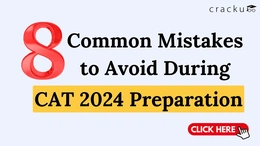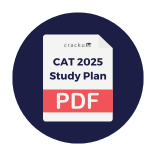Understanding geometry quadrilaterals is fundamental for excelling in the Geometry section of the CAT Quantitative Aptitude. Geometry plays a significant role in the CAT Quantitative Aptitude section, and one of the fundamental concepts within geometry is understanding quadrilaterals. Quadrilaterals are polygonal shapes with four sides. Mastering the properties, formulas, and theorems related to quadrilaterals is crucial for excelling in CAT exams. You can check out these CAT Geometry questions from the CAT Previous year papers.
Regular practice with free CAT mocks is highly recommended as it offers a comprehensive understanding of question patterns and refining strategies for tackling Geometry Quadrilateral questions efficiently. These mock tests are invaluable tools for familiarizing yourself with the questions commonly encountered in CAT exams.
Also Read, CAT Eligibility Criteria 2024
Question 1
If a rhombus has area 12 sq cm and side length 5 cm, then the length, in cm, of its longer diagonal is
correct answer:-1
Question 2
The sides AB and CD of a trapezium ABCD are parallel, with AB being the smaller side. P is the midpoint of CD and ABPD is a parallelogram. If the difference between the areas of the parallelogram ABPD and the triangle BPC is 10 sq cm, then the area, in sq cm, of the trapezium ABCD is
correct answer:-1
Question 3
A park is shaped like a rhombus and has area 96 sq m. If 40 m of fencing is needed to enclose the park, the cost, in INR, of laying electric wires along its two diagonals, at the rate of ₹125 per m, is
correct answer:-3500
Question 4
Let ABCD be a parallelogram. The lengths of the side AD and the diagonal AC are 10cm and 20cm, respectively. If the angle $$\angle ADC$$ is equal to $$30^{0}$$ then the area of the parallelogram, in sq.cm is
correct answer:-2
Question 5
A trapezium $$ABCD$$ has side $$AD$$ parallel to $$BC, \angle BAD = 90^\circ, BC = 3$$ cm and $$AD= 8$$ cm. If the perimeter of this trapezium is 36 cm, then its area, in sq. cm, is
correct answer:-66
Question 6
All the vertices of a rectangle lie on a circle of radius R. If the perimeter of the rectangle is P, then the area of the rectangle is
correct answer:-2
Question 7
Let ABCD be a parallelogram such that the coordinates of its three vertices A, B, C are (1, 1), (3, 4) and (−2, 8), respectively. Then, the coordinates of the vertex D are
correct answer:-4
Question 8
The lengths of all four sides of a quadrilateral are integer valued. If three of its sides are of length 1 cm, 2 cm and 4 cm, then the total number of possible lengths of the fourth side is
correct answer:-4
Question 9
A quadrilateral ABCD is inscribed in a circle such that AB : CD = 2 : 1 and BC : AD = 5 : 4. If AC and BD intersect at the point E, then AE : CE equals
correct answer:-3
Question 10
A rectangle with the largest possible area is drawn inside a semicircle of radius 2 cm. Then, the ratio of the lengths of the largest to the smallest side of this rectangle is
correct answer:-1
![Top CAT Geometry Quadrilateral Questions [Download PDF] Top CAT Geometry Quadrilateral Questions [Download PDF]](/media/CAT%20-%20GEOMETRY%20Quadrilaterals%20-%20%20Questions%20With%20Detailed%20Solutions%20.webp)




![Top 10 - CAT Geometry Triangles Questions [Download PDF] Top 10 - CAT Geometry Triangles Questions [Download PDF]](/media/cache/95/e1/95e12a34d491e2927874fa1244dc3c71.webp)


![Top CAT Geometry Cricles Questions [Download PDF] Top CAT Geometry Cricles Questions [Download PDF]](/media/cache/37/35/373563e7d0820dbbf9f140c7f5878cc0.webp)











